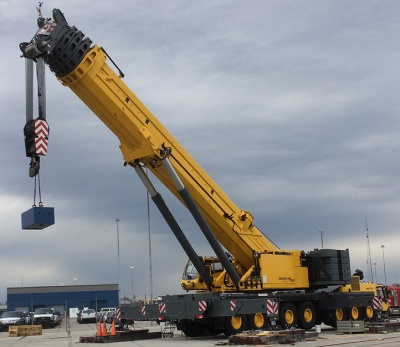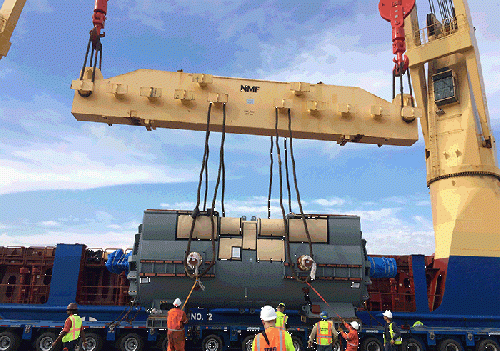Difference between revisions of "Near Shore and on Shore: Design Vehicles"
(→Trailers/Mafis) |
|||
| (4 intermediate revisions by 2 users not shown) | |||
| Line 9: | Line 9: | ||
=Primary Guidance= | =Primary Guidance= | ||
| − | Design vehicles govern the structural and geometric design of industrial waterfront facilities. The load and geometric vehicle demand | + | Design vehicles govern the structural and geometric design of industrial waterfront facilities. The load and geometric vehicle demand is far in excess of highway design standards and thus, constitute a significant cost determinant in both rehabilitation and reconstruction projects. The appropriate design vehicle choice is based on forecasted business needs within the completed project’s service life. |
Establish the remaining service life (major rehabilitation) or design service life (reconstruction) for the as-built condition. | Establish the remaining service life (major rehabilitation) or design service life (reconstruction) for the as-built condition. | ||
| Line 16: | Line 16: | ||
For reconstruction and new development, select design vehicles from all categories for the mid-point of the design service life (typically 75 years) based on engineering judgment, recommendations from manufacturers, and/or factored existing maximum vehicle loads and geometry. Accommodating all other design vehicles shall be achieved by implementing structural configurations that are optimized to readily permit the future structural retrofits necessary for their use, including crane rail beams (gantry cranes), heavy lift areas (mobile cranes/superload trailers), and rail pits (railcars). Using ballasted one way decks are not only more economical, but they are preferred over flat plate construction to achieve this flexibility. | For reconstruction and new development, select design vehicles from all categories for the mid-point of the design service life (typically 75 years) based on engineering judgment, recommendations from manufacturers, and/or factored existing maximum vehicle loads and geometry. Accommodating all other design vehicles shall be achieved by implementing structural configurations that are optimized to readily permit the future structural retrofits necessary for their use, including crane rail beams (gantry cranes), heavy lift areas (mobile cranes/superload trailers), and rail pits (railcars). Using ballasted one way decks are not only more economical, but they are preferred over flat plate construction to achieve this flexibility. | ||
| − | *Trailers/mafis : capacity determined by customer or max project cargo/superloads in State of MD (currently 1M# ); 100 ton minimum (major rehabilitation) | + | *Trailers/mafis: capacity determined by customer or max project cargo/superloads in State of MD (currently 1M# ); 100 ton minimum (major rehabilitation) |
*Forklifts: loaded container forklift; loaded front axle 125 tons | *Forklifts: loaded container forklift; loaded front axle 125 tons | ||
*Gantry cranes: 40 ton containers (major rehabilitation) and 60 ton containers (reconstruction) | *Gantry cranes: 40 ton containers (major rehabilitation) and 60 ton containers (reconstruction) | ||
| Line 23: | Line 23: | ||
*Railcars: Cooper E80 minimum | *Railcars: Cooper E80 minimum | ||
[[File:IMG_0058.JPG|400px|left]][[File:breakbulk25.jpg|400px|right]] | [[File:IMG_0058.JPG|400px|left]][[File:breakbulk25.jpg|400px|right]] | ||
| − | [[File:breakbulk27.gif| | + | [[File:breakbulk27.gif|500px|center]] |
|- | |- | ||
| colspan="3" | | | colspan="3" | | ||
| Line 31: | Line 31: | ||
==Trailers/Mafis== | ==Trailers/Mafis== | ||
| − | Multi-axle trailers transport oversize and overweight project cargo primarily within terminal boundaries. Axle loads of these trailers are typically far in excess of superload highway allowables . Tires may be pneumatic or solid rubber-steel composites. Multi-axle golfhofer trailers typically consist of 8 to 10 axles spaced approximately on 4 ft. centers and allow linking additional 4 to 6 axle units to the base trailer. Mafis are typically 2 or 3 axle trailers with a cargo rating in the range of 100 to 200 tons. A bogie is the total load on the bogie or all rear axles combined. Bogie loads often govern the design of non-ballasted decks and their framing. | + | Multi-axle trailers transport oversize and overweight project cargo primarily within terminal boundaries. Axle loads of these trailers are typically far in excess of superload highway allowables. Tires may be pneumatic or solid rubber-steel composites. Multi-axle golfhofer trailers typically consist of 8 to 10 axles spaced approximately on 4 ft. centers and allow linking additional 4 to 6 axle units to the base trailer. Mafis are typically 2 or 3 axle trailers with a cargo rating in the range of 100 to 200 tons. A bogie load is the total load on the bogie or all rear axles combined. Bogie loads often govern the design of non-ballasted decks and their framing. |
==Forklifts== | ==Forklifts== | ||
Latest revision as of 19:46, 7 December 2016
|
Design Vehicles
| ||
ContentsPrimary GuidanceDesign vehicles govern the structural and geometric design of industrial waterfront facilities. The load and geometric vehicle demand is far in excess of highway design standards and thus, constitute a significant cost determinant in both rehabilitation and reconstruction projects. The appropriate design vehicle choice is based on forecasted business needs within the completed project’s service life. Establish the remaining service life (major rehabilitation) or design service life (reconstruction) for the as-built condition. For major rehabilitation projects, select design vehicles from the relevant vehicle categories based on an operational forecast window no more than 20 years in the future or the remaining service life, whichever is less. Only those vehicles that are operationally necessary to the forecast business are included. For reconstruction and new development, select design vehicles from all categories for the mid-point of the design service life (typically 75 years) based on engineering judgment, recommendations from manufacturers, and/or factored existing maximum vehicle loads and geometry. Accommodating all other design vehicles shall be achieved by implementing structural configurations that are optimized to readily permit the future structural retrofits necessary for their use, including crane rail beams (gantry cranes), heavy lift areas (mobile cranes/superload trailers), and rail pits (railcars). Using ballasted one way decks are not only more economical, but they are preferred over flat plate construction to achieve this flexibility.
| ||
DiscussionTrailers/MafisMulti-axle trailers transport oversize and overweight project cargo primarily within terminal boundaries. Axle loads of these trailers are typically far in excess of superload highway allowables. Tires may be pneumatic or solid rubber-steel composites. Multi-axle golfhofer trailers typically consist of 8 to 10 axles spaced approximately on 4 ft. centers and allow linking additional 4 to 6 axle units to the base trailer. Mafis are typically 2 or 3 axle trailers with a cargo rating in the range of 100 to 200 tons. A bogie load is the total load on the bogie or all rear axles combined. Bogie loads often govern the design of non-ballasted decks and their framing. ForkliftsLoaded forklift front axle loads can exceed the axle loads imposed by mafis, particularly in facilities where containers are handled. Typical container forklift front axle loads range from 125 tons and higher. Other specialty forklifts may govern design. Truck Mounted CranesTruck mounted cranes and mobile harbor cranes deliver extreme loads to decks and substructure elements. Conventional 250 ton truck cranes impose outrigger loads in excess of 200 tons on a 30 inch square foot. 340 ton mobile harbor cranes are some of the largest cranes currently in use worldwide and at capacity impose single outrigger loads in excess of 600 tons. Tracked VehiclesThe live loads imposed by excavators and farm equipment do not typically govern the structural design of waterfront facilities. However, the tracks rapidly and extensively degrade the surface course of the berth and storage lots, particularly at locations where the vehicles turn and pivot. RCC and asphalt-overlaid RCC are the proven surface treatments. RailcarsRail loads in terminal are limited to a Cooper E80 due to the rating of rail infrastructure outside of the terminals. VesselsDesign vessel minima should be based on vessels currently in use by select business carriers. Vessel particulars for ships currently under development for deployment within typically no more than 5 years. See Also |


